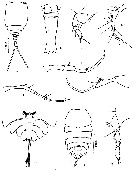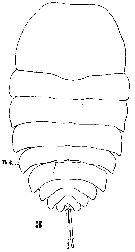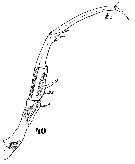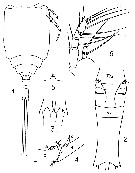|
|
 |
|
Cyclopoida ( Order ) |
|
|
|
Sapphirinidae ( Family ) |
|
|
|
Copilia ( Genus ) |
|
|
| |
Copilia lata Giesbrecht, 1891 (F,M) | |
| | | | | | | Syn.: | Copilia elliptica (M) Giesbrecht, 1892 (p.648, 658, 771, figs.M); Furuhashi, 1961 a (p.110) | | | | Ref.: | | | Giesbrecht, 1891; 1892 (p.648, 658, 771, fig.F); Wolfenden, 1911 (p.359); Lehnhofer, 1926 (p.132, 141, figs.F,M); Farran, 1929 (p.211, 291); Farran, 1936 a (p.134); Lysholm & al., 1945 (p.44); Sewell, 1947 (p.269); Paiva, 1971 (p.43, figs.M); Zheng & al., 1982 (p.131, figs.F,M); Chihara & Murano, 1997 (p.992, Pl.231,232: F,M); Boxshall, 1998 (p.228); Bradford-Grieve & al., 1999 (p.887, 972, figs.F,M); Boxshall & Halsey, 2004 (p.653); Vives & Shmeleva, 2010 (p.356, figs.F,M, Rem.) |  issued from : Z. Zheng, S. Li, S.J. Li & B. Chen in Marine planktonic copepods in Chinese waters. Shanghai Sc. Techn. Press, 1982 [p.131, Fig.81]. Female (from SE Korea):a, habitus (dorsal); b, urosome (dorsal); c, A2, d, P4. Male: e, habitus (dorsal); f, urosome (ventral); g, A1; h, A2; i, Mxp; j, P4. Scale bars in mm.
|
 Issued from : W. Giesbrecht in Systematik und Faunistik der Pelagischen Copepoden des Golfes von Neapel und der angrenzenden Meeres-Abschnitte. - Fauna Flora Golf. Neapel, 1892. Atlas von 54 Tafeln. [Taf. 50, Fig.3 ]. As Copilia elliptica. Male: 3, habitus (dorsal).
|
 Issued from : W. Giesbrecht in Systematik und Faunistik der Pelagischen Copepoden des Golfes von Neapel und der angrenzenden Meeres-Abschnitte. - Fauna Flora Golf. Neapel, 1892. Atlas von 54 Tafeln. [Taf. 50, Fig.35 ]. As Copilia elliptica. Male: 35, A2.
|
 Issued from : W. Giesbrecht in Systematik und Faunistik der Pelagischen Copepoden des Golfes von Neapel und der angrenzenden Meeres-Abschnitte. - Fauna Flora Golf. Neapel, 1892. Atlas von 54 Tafeln. [Taf. 50, Fig.40 ]. Female: 40, A2.
|
 issued from : C. Lehnhofer in Wiss. Ergebn. dt. Tiefsee-Exped. ''Valdivia'', 1926, 23 (1). [p.142, Textfig.17]. Female: 1, habitus (dorsal; arrow indicates frontal organ); 2, urosome (dorsal); 3, posterior part of anal segment (ventral); 4, segments 3 and 4 of A2; 5, frontal organ; 6, P4 (Ri = endopodite; Re = exopodite).
|
 issued from : C. Lehnhofer in Wiss. Ergebn. dt. Tiefsee-Exped. ''Valdivia'', 1926, 23 (1). [p.133, Textfig.11]. Male: 1, A2 (segment 2); 2, A2; 3, distal portion of segment 4 of A2; 4, Mxp.
| | | | | Compl. Ref.: | | | Oliveira, 1945 (p.191); Sewell, 1948 (p.346); Björnberg, 1963 (p.90, Rem.); Tranter, 1977 (p.596, 599); Guangshan & Honglin, 1984 (p.118, tab.); Böttger-Schnack, 1995 (p.93); Shih & Young, 1995 (p.77); Lo & al., 2004 (p.89, tab.1); Khelifi-Touhami & al., 2007 (p.327, Table 1, Rem.: p.329, 334); Neumann-Leitao & al., 2008 (p.799: Tab.II, fig.6); C.-Y. Lee & al., 2009 (p.151, Tab.2); Hsiao S.H. & al., 2011 (p.475, Appendix I) | | | | NZ: | 11 | | |
|
Distribution map of Copilia lata by geographical zones
|
| | | | | | | | | | | |  Chart of 1996 Chart of 1996 | |
 issued from : C. Lehnhofer in Wiss. Ergebn. dt. Tiefsee-Exped. ''Valdivia'', 1926, 23 (1). [p.170, Textfig.34]. issued from : C. Lehnhofer in Wiss. Ergebn. dt. Tiefsee-Exped. ''Valdivia'', 1926, 23 (1). [p.170, Textfig.34].
Zoogeographical distribution of C. lata. |
| | | | Loc: | | | Congo, off Ascension Is., G. of Guinea, off NE St. Paul Is., off Cape Verde Is., Canary Is., Rio de Janeiro, Bazsil, off Amazon, Sargasso Sea, off Azores (S & W), W Medit. (Algeria: Gulf of Annaba, El Kala shelf), Tyrrhenian Sea (Station Capo Gallo: latitude 38.23481, longitude 13.26413) and Mediterranean Sea - Canal of Sicily (Station Isola delle Correnti: latitude 36.603100, longitude 15.041670) [Pers. Comm. of E. Macaluso & P. Vitale, 2020], Bab al Mandab, G. of Aden, Arabian Sea, S Indian, W Australia, China Seas (East China Sea, South China Sea), Taiwan (E: Kuroshio Current, N: Mienhua Canyon, NW), Japan, Pacif. (N-S tropical), Pacif. (W equatorial), Australia (Great Barrier), off NW New Zealand | | | | N: | 31 | | | | Lg.: | | | (46) F: 4,25-4; M: 6,6-5,75; (237) F: 5,6; (310) M: 6,71-4,92; (703) F: 5,4-3,2; M: 7-4,5; (866) F: 4,75-4,2; (1023) F: 4,78; M: 6,66; {F: 3,20-5,60; M: 4,50-7,00} | | | | Rem.: |
After Björnberg (1963, p.90) this species is rare from the Brazilian waters, only taken off the northern coast of Brazil in warm and very saline waters.
For Khelifi-Touhami & al. (2007, p.334) the occurrence of this species in south-western Mediterranean may indicate the influence of oceanic waters advecting the modified Atlantic water to the coastal area. The presence may also reflect the tropicalisation of the Mediterranean as a consequence of the general water warming (See in Lakkis & al., 2002). | | | Last update : 19/08/2020 | |
|
|
 Any use of this site for a publication will be mentioned with the following reference : Any use of this site for a publication will be mentioned with the following reference :
Razouls C., Desreumaux N., Kouwenberg J. and de Bovée F., 2005-2025. - Biodiversity of Marine Planktonic Copepods (morphology, geographical distribution and biological data). Sorbonne University, CNRS. Available at http://copepodes.obs-banyuls.fr/en [Accessed October 16, 2025] © copyright 2005-2025 Sorbonne University, CNRS
|
|
 |
 |









